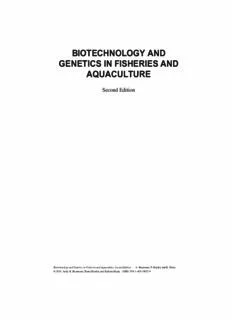Table Of ContentP1:OTE/PGN P2:OTE/PGN QC:OTE/PGN T1:OTE
BLBK242-FM BLBK242-Beaumont January15,2010 16:44 PrinterName:YettoCome
BIOTECHNOLOGY AND
GENETICS IN FISHERIES AND
AQUACULTURE
Second Edition
Biotechnology and Genetics in Fisheries and Aquaculture, Second Edition A. Beaumont, P. Boudry and K. Hoare
© 2010 Andy R. Beaumont, Pierre Boudry and Kathrin Hoare. ISBN: 978-1-405-18857-9
i
P1:OTE/PGN P2:OTE/PGN QC:OTE/PGN T1:OTE
BLBK242-FM BLBK242-Beaumont January15,2010 16:44 PrinterName:YettoCome
BIOTECHNOLOGY AND
GENETICS IN FISHERIES AND
AQUACULTURE
Second Edition
Andy Beaumont
SchoolofOceanSciences
BangorUniversity
Wales,UK
Pierre Boudry
Ifremer
UMRM100PhysiologieetEcophysiologiedesMollusquesMarins
TechnopoledeBrest-Iroise
Plouzane´,France
Kathrin Hoare
SchoolofOceanSciences
BangorUniversity
Wales,UK
A John Wiley & Sons, Ltd., Publication
iii
P1:OTE/PGN P2:OTE/PGN QC:OTE/PGN T1:OTE
BLBK242-FM BLBK242-Beaumont January15,2010 16:44 PrinterName:YettoCome
Thiseditionfirstpublished2010
(cid:2)C 2010byAndyR.Beaumont,PierreBoudryandKathrinHoare
Firsteditionpublished2003
BlackwellPublishingwasacquiredbyJohnWiley&SonsinFebruary2007.Blackwell’spublishing
programmehasbeenmergedwithWiley’sglobalScientific,Technical,andMedicalbusinesstoform
Wiley-Blackwell.
Registeredoffice
JohnWiley&SonsLtd.TheAtrium,SouthernGate,Chichester,WestSussex,PO198SQ,UnitedKingdom
Editorialoffices
9600GarsingtonRoad,Oxford,OX42DQ,UnitedKingdom
2121StateAvenue,Ames,Iowa50014-8300,USA
Fordetailsofourglobaleditorialoffices,forcustomerservicesandforinformationabouthowtoapplyfor
permissiontoreusethecopyrightmaterialinthisbook,pleaseseeourwebsiteat
www.wiley.com/wiley-blackwell.
Therightoftheauthortobeidentifiedastheauthorofthisworkhasbeenassertedinaccordancewiththe
Copyright,DesignsandPatentsAct1988.
Allrightsreserved.Nopartofthispublicationmaybereproduced,storedinaretrievalsystem,ortransmitted,
inanyformorbyanymeans,electronic,mechanical,photocopying,recordingorotherwise,exceptas
permittedbytheUKCopyright,DesignsandPatentsAct1988,withoutthepriorpermissionofthepublisher.
Wileyalsopublishesitsbooksinavarietyofelectronicformats.Somecontentthatappearsinprintmaynot
beavailableinelectronicbooks.
Designationsusedbycompaniestodistinguishtheirproductsareoftenclaimedastrademarks.Allbrand
namesandproductnamesusedinthisbookaretradenames,servicemarks,trademarksorregistered
trademarksoftheirrespectiveowners.Thepublisherisnotassociatedwithanyproductorvendormentioned
inthisbook.Thispublicationisdesignedtoprovideaccurateandauthoritativeinformationinregardtothe
subjectmattercovered.Itissoldontheunderstandingthatthepublisherisnotengagedinrendering
professionalservices.Ifprofessionaladviceorotherexpertassistanceisrequired,theservicesofa
competentprofessionalshouldbesought.
LibraryofCongressCataloging-in-PublicationData
Beaumont,A.R.(AndyR.)
Biotechnologyandgeneticsinfisheriesandaquaculture/AndyR.
Beaumont,PierreBoudry,KathrinHoare.–2nded.
p.cm.
Includesbibliographicalreferencesandindex.
ISBN978-1-4051-8857-9(hardback:alk.paper)
1.Fishes–Moleculargenetics. 2.Fishes–Breeding. I.Boudry,Pierre. II.Hoare,K.. III.Title.
SH155.5.B432010
639.3–dc22
2009031829
AcataloguerecordforthisbookisavailablefromtheBritishLibrary.
(cid:2)
Setin10/12ptTimesbyAptaraR Inc.,NewDelhi,India
PrintedinSingapore
1 2010
iv
P1:OTE/PGN P2:OTE/PGN QC:OTE/PGN T1:OTE
BLBK242-FM BLBK242-Beaumont January15,2010 16:44 PrinterName:YettoCome
Contents
Prefacetothesecondedition ix
Acknowledgements xi
Chapter1 Whatisgeneticvariation? 1
Deoxyribosenucleicacid 1
Ribosenucleicacid 5
Whatisthegeneticcode? 7
Proteinstructure 7
Sowhataboutchromosomes? 9
Howdoessexualreproductionproducevariation? 11
MitochondrialandchloroplastDNA 16
Chapter2 Howcangeneticvariationbemeasured? 19
DNAsequencevariation 19
DNAfragmentsizevariation 36
Proteinvariation 44
Phenotypicvariation 47
Chapter3 Geneticstructureinnaturalpopulations 49
Whatisapopulation? 49
Howareallelefrequenciesestimated? 51
Whatistherelationshipbetweenallelesandgenotypes? 51
Howdoallelefrequencieschangeovertime? 53
Howdoespopulationstructurearise? 54
Howaregeneticmarkersusedtostudypopulationstructure? 55
Levelsofgeneticdifferentiationinaquaticorganisms 60
Potentialproblemswithallozymesandcodingmarkers 61
mtDNAvariation 63
Microsatellitevariation 66
Populationstructureintheflatoyster 68
Mixedstockanalysis(MSA) 73
v
P1:OTE/PGN P2:OTE/PGN QC:OTE/PGN T1:OTE
BLBK242-FM BLBK242-Beaumont January15,2010 16:44 PrinterName:YettoCome
vi Contents
Chapter4 Geneticsofpopulationsizeinconservation
andaquaculture 77
Geneticsofsmallpopulationsizeinthewild 78
Geneticmarkersinconservation 82
Geneticsofsmallpopulationsizeinthehatchery 85
Isthereevidenceoflossofgeneticvariationinthehatchery? 87
Howdoeshatcherypropagationaffectheterozygosity? 89
Geneticmarkersforidentificationofhatcheryproduct 93
Geneticmarkersforpathogenidentification 94
Chapter5 Geneticvariationoftraits 99
Qualitativetraits 99
Quantitativetraits 105
Whatkindsoftraitsareimportant? 106
Variationofaquantitativetrait 106
Howcanweestimatenarrow-senseheritability? 109
Realisedheritability 115
Correlatedtraits 118
Whattypesofartificialselectionsarethere? 118
Settingupabreedingprogramme 122
Inbreeding,cross-breedingandhybridisation 123
Currentstatusofselectivebreedingprogrammesinaquaculture 126
Chapter6 Fromgeneticstogenomics 129
Whatisthegenome? 129
Genomemapping 130
Wholegenomesequencing:the‘bigpicture’ 137
QTLmapping 137
ApplicationofQTLsinaquacultureandfisheriesmanagement 138
Marker-assistedselection(MAS):fromQTLstogenomicselection 139
Transcriptomics 139
Chapter7 Triploidsandbeyond:whymanipulateploidy? 145
Howisitdone? 146
Productionofgynogensandandrogens 148
Identificationofploidychange 149
ValueofTriploids 151
Tetraploids 155
Gynogensandandrogens 157
P1:OTE/PGN P2:OTE/PGN QC:OTE/PGN T1:OTE
BLBK242-FM BLBK242-Beaumont January15,2010 16:44 PrinterName:YettoCome
Contents vii
Chapter8 Geneticengineeringinaquaculture 161
TheDNAconstruct 162
Transgenedelivery 164
Transgeneintegration 168
Detectingintegrationandexpressionofthetransgene 169
Resultsoftransgenesiseffortsinfish 171
Somuchfortransgenics–whataboutcloning? 176
Genethics 176
Glossary 181
Index 193
Colourplatesappearbetweenpages52and53
P1:OTE/PGN P2:OTE/PGN QC:OTE/PGN T1:OTE
BLBK242-FM BLBK242-Beaumont January15,2010 16:44 PrinterName:YettoCome
Preface to the second edition
Therateofchangeinthefieldofmoleculargeneticshasbeenextremelyfastsincethe
development of DNA sequencing methodologies and the polymerase chain reaction.
The new millennium has seen increasing miniaturisation and sophistication of these
techniques,andthishasledtosecond-generationsequencingmethodsthatcanproduce
hundreds of thousands of DNA sequences from an organism in a very short space of
time.Becauseofthepaceofthesetechnologicalchanges,somepartsofthefirstedition
ofthisbookquicklybecameoutdated.
This second edition benefits from the addition of a new author (Dr Pierre Boudry)
and in updating the book to take account of new technologies, we have taken the
opportunitytocorrecterrors,improveandreorganisethematerialfromthefirstedition.
Several chapters retain the same headings but with new material added to bring them
rightuptodate.Usingmaterialfromthefirsteditionandaddingfreshtextandfigures,
we have introduced a new chapter based around the genetics of population size that
links directly to problems in aquaculture and in conservation. In addition, we have
providedanewchaptercalled‘Geneticstogenomics’thatcoversrecentdevelopments
in genetic mapping, the search for quantitative trait loci and introduces the subject of
transcriptomics–thetranscriptionofDNAsequencetoRNA.
We have retained the introductory-level nature of the book but have increased the
numberofreferencesattheendofeachchapterformoreadvancedreaders.
ix
P1:OTE/PGN P2:OTE/PGN QC:OTE/PGN T1:OTE
BLBK242-FM BLBK242-Beaumont January15,2010 16:44 PrinterName:YettoCome
Acknowledgements
The following have kindly given us permission to use some of their material in the
illustrations for the book: Dr Ann Wood, Dr Karen Abey, Dr Shelagh Malham, Dr
CraigWilding,ChrisBeveridge,AlixTaylorandNatalieHorton.Wethankthescientific
publishingcompaniesthathaveallowedustousefiguresfrompublishedsourcesandall
suchcompaniesareacknowledgedinfigurelegends.
WethankDavidRobertsfromtheSchoolofOceanSciences,BangorUniversity,for
photographyandassistingwithpreparationoffigures.
Dr Pierre Boudry thanks the members of the Working Group on the Application of
GeneticsinFisheriesandMariculture(InternationalCouncilfortheExplorationofthe
Sea)forsharingideasandknowledge.
This second edition of the book would not have appeared without the support and
encouragementofNigelBalmforthandthekeeneditorialassistanceofKateNuttalland
CatrionaDixonofWiley-Blackwell.
xi
P1:SFK/UKS P2:SFK
BLBK242-COLOUR-PLATE BLBK242-Beaumont December31,2009 12:20 PrinterName:YettoCome
PlateB2.1 Athermalcyclerinwhichpolymerasechainreactioniscarriedout.During
polymerasechainreactiontheheatedlidisclosedoverthemicro-titreplatewhichispositionedin
theheatingblock.
PlateB2.2 Agarosemini-gelshowingpipettingofDNAsampleintoseparatewellspositioned
acrossthegel.Thegelispreparedbypouringitintoamouldandallowingittoset.Thewellsare
castintothegelduringthisprocess.Samplesarecolouredtomonitortheprogressof
electrophoresis.
Biotechnology and Genetics in Fisheries and Aquaculture, Second Edition A. Beaumont, P. Boudry and K. Hoare
© 2010 Andy R. Beaumont, Pierre Boudry and Kathrin Hoare. ISBN: 978-1-405-18857-9
1
P1:SFK/UKS P2:SFK
BLBK242-COLOUR-PLATE BLBK242-Beaumont December31,2009 12:20 PrinterName:YettoCome
PlateB2.3 SlabgelDNAsequencershowingtheupperandlowerbuffertrays.Theverythingel
issandwichedbetweentwoglassplatesconnectedtotheupperandlowerbuffertrays.Inset
showsdetailofthesharks-toothcombrestingonthetopofthegel.Upto98samplescanbe
appliedindividuallyintoeachofthesmallchambersbetweentheteeth.
PlateB2.4 ReadoutfromacapillarygelDNAsequencerusingtheSangermethod.Each
colouredpeakrepresentsasinglebase(blue,cytosine;red,thymine;black,guanine;green,
adenine)andthesequenceofbasesisgivenabovethegraphic.
2
Description:Following the extremely well-received structure of the first edition, this carefully revised and updated new edition now includes much new information of vital importance to those working and researching in the fisheries and aquaculture industries. Commencing with chapters covering genetic variation

